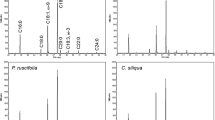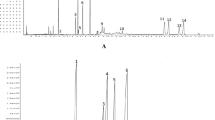Abstract
The ratios of stable carbon isotopes (13C/12C) of ganoderma fruiting body, ganoderma spore, ganoderma spore lipid (GSL) and individual fatty acids in GSL were determined by gas chromatography–stable isotope ratio mass spectrometry and elemental analysis–stable isotope ratio mass spectrometry. These values fall into a range from −26.9 to −23.3‰, suggesting that the cut log as the Ganoderma-cultivated substrate in Fujian, China, may belong to C3 plants. Eighteen fatty acids were identified and their abundances measured by gas chromatography–mass spectrometry in the six GSL samples with C16:0, C18:0, C18:1 and C18:2 as major constituents, and C16:1 is evidently enriched compared with the other edible vegetable oils. On the basis of the compositions of fatty acids and stable carbon isotopes in GSL, we have developed a novel method to detect the adulteration of GSL products with cheaper edible vegetable oils. An example of ideal blending between GSL and C4 or C3 vegetable oil is further provided to expound the discrimination procedures and corresponding sensitive indicators. Simultaneously, the carbon isotope fractionation in the biosynthesis of individual fatty acids was observed, revealing that the formation of C18:0 from C16:0 in ganodema spores had no conspicuous 13C enrichment of +0.4‰ for Ganoderma sinensis spore and +0.1‰ for G. lucidum spore; the desaturation of C18:0 to C18:1 resulted in a distinct 13C depletion of −1.4‰ for G. sinensis spore and −0.9‰ for G. lucidum spore; and the next desaturation from C18:1 to C18:2 displayed no evident 13C fractionation of −0.1‰ for G. sinensis spore and −0.2‰ for G. lucidum spore.

Ganoderma lucidum has been widely used in traditional Chinese medicines. Ganoderma spore lipid (GSL) extracted from the spores of G. lucidum has been approved as a health food supplement. However, because of rarity, GSL has become a target for adulteration with cheaper vegetable oils.



Similar content being viewed by others
References
Mo HY, Hong MH, Zhang JM, Chen DL, Ma J, Su Y, Guo X, Huang XM, Qiu F, Li LY (1999) Chin J Clin Oncol 26:216–218
Weis AL (1999) Crit Rev Immunol 19:65–96
Lin ZB (ed) (2001) Modern research of Ganoderma. Medical University Press, Beijing
Liu X, Wang JH, Yuan JP (2005) J Nanosci Nanotech 5:2001–2013
Min BS, Nakamura N, Miyashiro H, Bae KW, Hattori M (1998) Chem Pharm Bull 46:1607–1612
Liu X, Yuan JP, Chung CK, Chen XJ (2002) Cancer Lett 182:155–161
Sliva D, Sedlak M, Slivova V, Valachovicova T, Lloyd FPJ, Ho NW (2003) J Altern Complement Med 9:491–497
Gan KH, Fann YF, Hsu SH, Kuo KW, Lin CN (1998) J Nat Prod 61:485–487
Lin JM, Lin CC, Chen MF, Ujiie T, Takada J (1995) J Ethnopharmacol 47:33–41
Yen GC, Wu JY (1999) Food Chem 65:375–379
El-Mekkawy S, Meselhy MR, Nakamura N, Tezuka Y, Hattori M, Kakiuchi N, Shimotohno K, Kawahata T, Otake T (1998) Phytochem 49:1651–1657
Yoon SY, Eo SK, Kim YS, Lee CK, Han SS (1994) Arch Pharm Res 17:438–442
Kim HW, Shim MJ, Choi EC, Kim BK (1997) Arch Pharm Res 20:425–431
Wasser SP, Weis AL (1999) Int J Med Mushrooms 1:31–62
Cheung WMW, Hui WS, Chu PWK, Chiu SW, Ip NY (2000) FEBS Lett 486:291–296
Wang JH, Yuan JP, Huang L (2003) Nutr Food Hyg 93:38–39
Huie CW, Di X (2004) J Chromatogr B 812:241–257
Wang JH, Yuan JP, Xu SP, Liu X (2004) J Chin Inst Food Sci Technol 4:76–79
Chen TQ, Li KB, Lin XS, Xu J, Zheng Y, Lin ZY (2001) Acta Agric Univ Jiangxi 23:26–29
Chen TQ, Li KB, Xu J, Zhu PG, Zheng Y (1997) Mycosystems 16:52–56
Chen TQ, Wu JZ, Xu J, Li Y (2005) J Fungal Res 3:35–38
Tian YF, Li JH, Yu DS (2003) China Oils Fats 28:44–45
Hsu RC, Lin BH, Chen CW (2001) Ind Eng Chem Res 40:4478–4481
Craig H (1957) Geochim Cosmochim Acta 12:133–149
Abraham WR, Hesse C (2003) FEMS Microbiol Ecol 46:121–128
Ruess L, Tiunov A, Haubert D, Richnow HH, Häggblom MM, Scheu S (2005) Soil Biol Biochem 37:945–953
Benson S, Lennard C, Maynard P, Roux C (2006) Forensic Sci Intl 157:1–22
Doner LW, White JW (1977) Science 197:891–892
Chen TQ, Li KB, Zheng Y, He XJ (1995) J Fujian For Sci Technol 22:62–66
Hayes JM (2001) Rev Mineral Geochem 43:225–278
Schmidt TC, Zwank L, Berg MEM, Meckenstock RU, Haderlein SB (2004) Anal Bioanal Chem 378:283–300
Meier-Augenstein W (1999) J Chromatogr A 842:351–371
Kelly S, Parker I, Sharman M, Dennis J, Goodall I (1997) Food Chem 59:181–186
Woodbury SE, Evershed RP, Rossell JB, Griffith RE, Farnell P (1995) Anal Chem 67:2685–2690
Woodbury SE, Evershed RP, Rossell JB (1998) J Am Oil Chem Soc 75:371–379
Angerosa F, Camera L, Cumitini S, Gleixner G, Reniero F (1997) J Agric Food Chem 45:3044–3048
Angerosa F, Breas O, Contento S, Guillou C, Reniero F, Sada E (1999) J Agric Food Chem 47:1013–1017
Yuan JP, Wang JH, Liu X, Kuang HC, Huang XN (2006) J Agric Food Chem 54:6172–6176
Řezanka T, Řezanková H (1999) Anal Chim Acta 398:253–261
Author information
Authors and Affiliations
Corresponding author
Rights and permissions
About this article
Cite this article
Liu, X., Xu, SP., Wang, JH. et al. Characterization of ganoderma spore lipid by stable carbon isotope analysis: implications for authentication. Anal Bioanal Chem 388, 723–731 (2007). https://doi.org/10.1007/s00216-007-1270-7
Received:
Revised:
Accepted:
Published:
Issue Date:
DOI: https://doi.org/10.1007/s00216-007-1270-7




